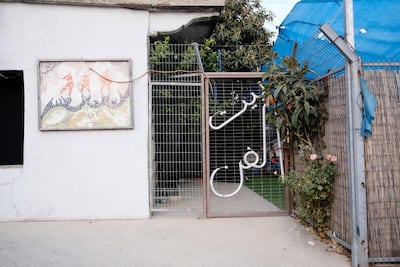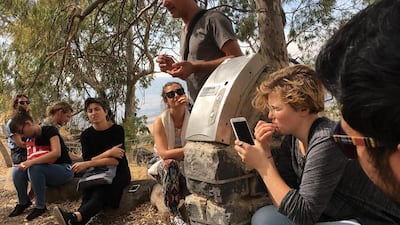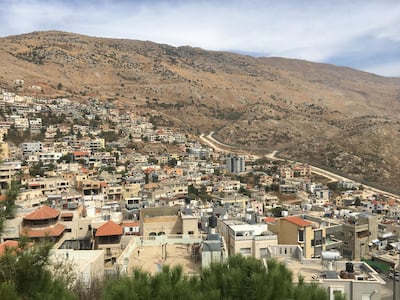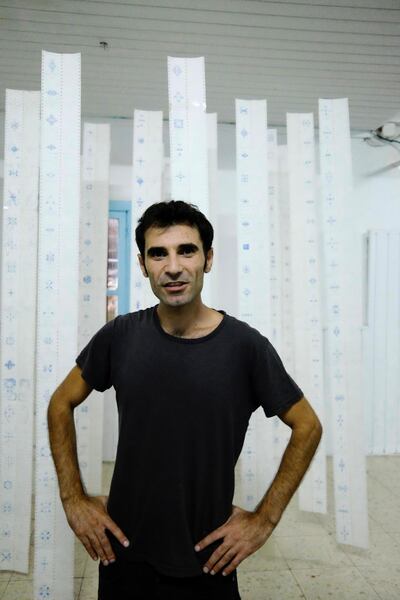With a kindly face and greying hair, Wael Tarabieh gives off the slightly rueful air of a long-time teacher who can't yet retire.
Tarabieh is an artist who lives in the Golan Heights, Syrian territory that Israel took in the 1967 Arab-Israeli conflict and has been occupying ever since. Set upon a range of hills, it boasts the only ski area in Israel, a minimal affair watched over by a giant snowman with a carrot nose. Just south is the Crusades-era Nimrod citadel, and beyond that, the Sea of Galilee. Its famous apple trees are now in season, and jackets and tight-knit hats are coming out of closets in the cooler weather.
The theme this year for the Qalandiya International, the biennial Palestinian exhibition of art, was “Solidarity”, and its organisers in Ramallah and Jerusalem reached out to the artist community in the Golan. Despite its size, Majdal Shams, the main city in the area, has a substantial arts scene. At its heart is the Fateh Al Mudares Art Centre, which Tarabieh and others reopened this year after a half-decade hiatus, and which collaborated with Qalandiya to host a show of the Golan artist Akram Al Halabi. A second exhibition called The Fourth Line, in Ramallah, exhibited a range of works, from stone sculpture to video, made by artists in the region.
The Golan Heights scene relaunches
This second version of the Fateh Al Mudares Art Centre, by coincidence, occupies the site of its progenitor, the former Bait al Fen, or House of Arts. Tarabieh was also part of the founding of that site in the late 1990s. The space closed within two years after a dispute with the NGO that was funding it – all fifteen of its artist members, Tarabieh tells me, quit en masse. In 2004, those artists formed the Fateh Al Mudares Art Centre, naming it after the Kurdish-Syrian modernist painter, who studied in Italy and returned home to share his knowledge with young Syrian artists. Over almost a decade, the Centre hosted classes and exhibitions, and organised festivals among the local population, installing stone sculptures, for example, along the side of the main roads. In 2013, they had to give up the centre because of the dire economic situation in the Golan.
When they relaunched it this year, by luck, the Bait al Fen building – an old house, with low, rocky ceilings and wooden doors painted baby blue – was available. They whitewashed the walls for the exhibition space, and used the empty rooms for storage (and clutter). Bamboo screens have been stretched over the ceiling in a makeshift bar area, with dark red velour seating and a table full of ashtrays. Artificial grass covers a space outdoors, where a few blue tarpaulins provide shade. Letters made of welded steel on the door read “Bait al Fen”. They are back where they began.
The same could be said for the cultural scene in Majdal Shams. “We are trying to start again from zero,” says Tarabieh about the five years that the centre was closed – a time in which, importantly, the Syrian Civil War raged across the Golan’s border. “The emptiness was very bad. In the past five years, all the civil initiatives and youth activities ceased to work. The Israeli side used this period to launch its ideological programmes among the youth in Golan. The hate speech was very strong. We have to renew our activity and work again with young people, but it’s much more difficult these days. We don’t have any resources.”
Confused identity in the Golan after the Syrian Civil War
The Syrian Civil War has created an identity crisis within the Golan. Since 1967, people in Golan Heights have wanted to rejoin Syria: to be in the heart, not on the side, as slogans had it. Majdal Shams is home to the “shouting valley”, where families separated by the 1967 border used to speak to each other via megaphones, shouting across the UN-imposed, mine-laden buffer. On holidays such as Mother’s Day, Golan artist Shada Safadi tells me, families would co-ordinate about what colour they would dress in, so they could be more easily spotted among the crowds. Residents knew the areas of Majdal Shams that carried sound best, and would position themselves strategically. This practice largely died out in the early 2000s, when the internet and mobile phones made communicating easier. And since the Civil War, Syrian civilians have been unable to travel to the border, which is under the control of the Assad regime.
“Now the Israelis say to us: ‘If you don’t like us, go to Daesh,’” Tarabieh says. The Israeli government has used the opportunity to inflame sectarian tensions within the Golan population, which is mostly Druze, and to bring some of the population closer to Israel. The recent elections in the Golan, which are being held for the first time since the occupation, are a case in point. “Twenty years ago, we would never talk about elections. It would have been forbidden – because it would mean you are recognising the occupation,” Tarabieh explains. “Now some people just want to be Israeli Druze.”
Students from Golan Heights used to receive leave from Israel to study in Damascus, but this practice stopped when the Civil War made it too dangerous to be there. Now, these relations are being lost. “Young people who have never been to Syria are connected to Haifa and Jerusalem and Tel Aviv, not to Damascus.
“The question of identity is very confused,” he continues. “Some of the people say we are Syrians, some of them say we are Druze, and some of them say, we don’t know who we are. A minority are clearly saying we are Israelis. But we don’t have statistics. We don’t have research to talk with confidence about what’s going on.”

Tarabieh also works at Al Marsad, a civil rights NGO in the Golan. It investigates Israeli claims and works to amend school curricula to include information about the occupation of Palestine and the Golan’s own history. Taking us to the site of the battle of Tel Faher, for example, which was decisive in the 1967 Israeli campaign, Tarabieh notes that the site’s commemoration of the battle includes every Israeli soldier’s name, but none of the Syrians who defied the order to evacuate and sought to defend the hilltop. It’s not an easy task to rehabilitate this past. Some of the Syrian soldiers scratched their names and home towns on the ceiling of the Tel Faher bunker before dying in battle. When she was studying in Damascus, Safadi, the artist, tried to find out who they were and alert the families in Syria as to what happened. But, she says, she was rebuffed by the Syrian authorities.
Reopening the Fateh Al Mudares Art Centre is one way the artists are initiating a Golan-led cultural curriculum and working for greater self-sufficiency. They have also begun to look towards Palestine for collaboration. “The choice we are given in the arts is between the Israelis and the Syrian regime,” Tarabieh says. “But there is a third choice: the Palestinian one.”
________________________
Read more:
Art under occupation: Qalandiya International opens in Ramallah and Jerusalem
WATCH: Why is the Golan Heights so important?
Israel says ready for UN crossing with Syria to reopen
________________________
For his Qalandiya International show, Akram Al Halabi returned to the Golan from Vienna, where he now lives, and organised Snowflakes, an exhibition like a self-retrospective. Long panels of carbon paper were his show project for his MA degree at the Academy of Art in Vienna. They too reflected on the confused question of identity in the Golan; they were a response, he says, to “the question of how I can define myself as an undefined person.”
Over a period of months he asked different people to imprint designs on rolls of carbon paper, and to sign his or her name and home town, in a hanging homage to various encounters and identities. A series of text pieces were made at the start to the Syrian conflict. Al Halabi took screenshots of the early violent protests and wrote in text over the body parts they depicted: “face,” “throat,” “hand,” “head.” He then deleted the image, so that the works give the impression of a body becoming hidden and covered up.
Next to these hangs a technically accomplished drawing of three skulls that Al Halabi made while taking drawing courses in high school in that very same building, when it was the Bait al Fen. They are testament to his formal, classical training – and to his first teacher, Wael Tarabieh.
Snowflakes in Golan Heights and The Fourth Line in Ramallah, part of Qalandiya International, are on until October 10




